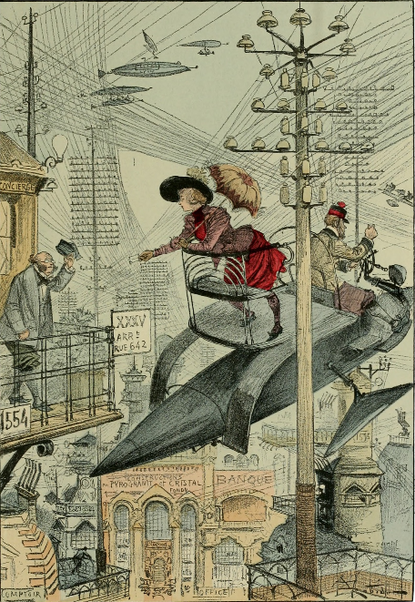RICHARD ANSETT: "I walk a very narrow path between success and failure"
Asia Bazdyrieva: The exhibition you participate in IZOLYATSIA is an artists-in-residence project for photographers. You have spent a few weeks in Donetsk last summer, which is quite unique experience. Tell us about your overall Ukrainian experience...
Richard Ansett: In the very act of leaving the confines imposed on my life in the UK, i was free to explore some deeply personal notions of damage and personal identity and in the process i feel i developed a close empathy with Ukraine as a state and people. I arrived consumed by fear of failure and re-directed that energy into work. I cannot remember feeling so much in such a short period of time. Ukraine brought out great passions in me that i felt I had lost touch with.
- Have you ever participated in such kind residences and what’s new that you gained with this experience?

Boy with Head Injury © Richard Ansett 2011/IZOLYATSIA Foundation for Cultural Initiatives
- No. This was the first time i felt there was the support i needed and a time frame that was manageable. It allowed me to completely immerse myself in the development of new work in a very supportive and non-judgemental environment. Ultimately i have gained most through the creation of new works of great personal importance.
- It is known that the aim of Partly Cloudy project is to attract the attention of artists worldwide to the Donetsk region as a new space for contemporary art. How would you define the potential impact of the project?
- It may seem eccentric to introduce the concept of fine art practice on such a large scale in Donetsk. I feel that IZOLYATSIA are extraordinary people working incredibly hard under very difficult circumstances to make a difference to their own country. They are an inspiration to anyone who feels change isn't possible. Contemporary Art introduces complex ideas to audiences otherwise unexposed. I know from the experience of visiting Donetsk that the presence of IZOLYATSIA has offered hope of something beyond the established expectations to a new generation of Ukrainian. It maybe a difficult journey but if art can inspire a single person to dare to hope for more, then it is worth it.
Many great artists came from humble backgrounds and were discovered and nurtured. Your own great Taras Shevchenko was a serf before he was apprenticed by his master Pavel Englehardt and would never have reached his iconic status without the early support of other artists and enlightened members of society around him.
Great things are only possible if we dare to push at the boundaries around us, nothing comes of co-existing in the status quo. I am very grateful to IZOLYATSIA for supporting my own journey.
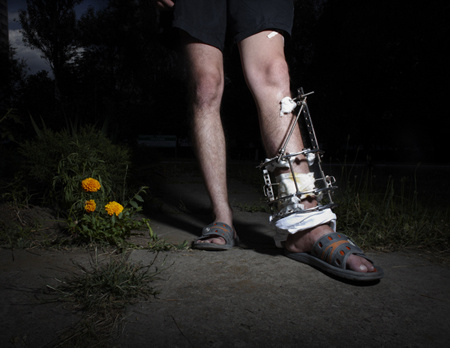
© Richard Ansett 2011/IZOLYATSIA Foundation for Cultural Initiatives
- The project was initiated in collaboration with Boris Mikhailov who is an iconic artist for Ukraine. It is really difficult to avoid comparisons between his and your photography. Especially in your Hospital Garden series. Do you recognize Mikhailov as an influencing on your artistic practice figure?
- Mikhailov is recognised worldwide as one of the most important figures in 20th century photography.
We see parts of our own practice in the work of others and are drawn to works because of a unique resonance, it is a personal connection and not necessarily or even likely to be the sameas others.
I discovered Mikhailov's 'Case History' at the second hand art bookshop in London and it had an immediate effect. From a Western capitalist perspective the work is political and subversive, it has a contemporary meaning beyond its antecedence. It is a benchmark; the definition of dissident action, a challenge to Capitalism's passive aggressive attack on the aesthetic landscape. It shatters every possible aesthetic and moral boundary and in doing so, it is corruption exposed through the very act of corruption.
As an artist my objective is to be free of the forces that seduce me to conform to an aesthetic conservatism. This is the corruption of ambition and it is a wholly destructive force in the creation of works of any possible value. In Case History I saw for the first time how far i was from my goal and how limited my personal achievements were and this inspired me further.
So yes, i may not have even applied for the residency without this Mikhailov connection, his works had already allowed me to feel that my practice had some value and i was less alone but the opportunity to collaborate was a catalyst.
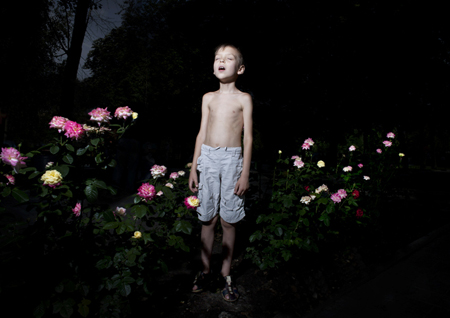
© Richard Ansett 2011/IZOLYATSIA Foundation for Cultural Initiatives
- Tell us about the Hospital Garden project. What was your initial impulse to work with people in hospital?
- The simple nature of the physical act of taking a photograph masks the complexities of creating works which are capable of resonating with a wider audience. Because of the instantaneous nature of the act , the initial impetus is not always immediately apparent; subconscious motivations during the process of creation can only be analysed in hindsight. In my early letter of intent to IZOLYATSIA, i was determined to leave behind any patronising, post colonial sense of judgement of a society. I was looking for an empathy with Ukraine as a state and people. I was seeking a project undefined by nationalistic boundaries, but more a shared humanity, a shared metaphor. I arrived in Donetsk, more emotionally damaged than usual and when introduced to the first hospital garden with the inhabitants wandering around with there broken and damaged limbs, i felt compelled to begin a project there. It was the beginning of a self -exploration through the lives of others and ended with an empathy.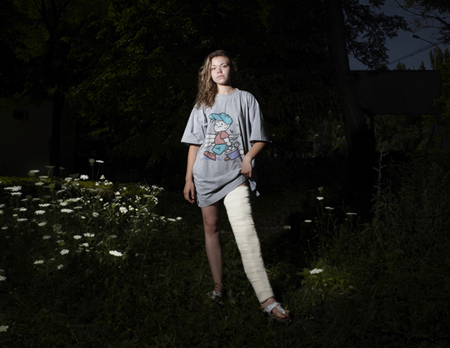
© Richard Ansett 2011/IZOLYATSIA Foundation for Cultural Initiatives
- You work with the genre of classic portrait. It is very interesting to see how blurred are the limits between genres and even epochs. One can see a reference to classical painting and sculpture in your photography. I reckon the notion of genre is very important to you...
- There is an element of propaganda in my practice that requires the use of some established aesthetic criteria including many references to make a connection with an audience. I do have a relationship, with the composition of the Arnolfini Portrait by Yan Van Eyke and i argue that the renaissance as art movement is responsible for the narrow aesthetic rules that define the modern world which are assumed as natural. My work has been compared to painting before but i do not seek that and do not pursue a direct link, I am a photographer, I work in the visual medium of the age, I do not seek any association to nostalgia even within the medium itself.
I use lighting as a concept of control of environment and to declare my presence as protagonist within the sense of reality truth associated with the photograph. This has been misinterpreted as quality and my practice is criticised for being too close to commercial aesthetic. I don't feel i belong to any one genre whilst being compared and feel close in some ways to the Dusseldorf School's New Objectivity which has been much criticised in itself but this is not the whole truth.
All practice is informed by an education; the more we understand the deeper and more elaborate the references, elements of genre and epoch are inevitably reflected in all practice. I am inspired by the harsh reality of Otto Dix and his ability to continue to produce works within an oppressive regime, who were unable to fully define him; he produced works of scathing allegory masked by a veneer of acceptability.
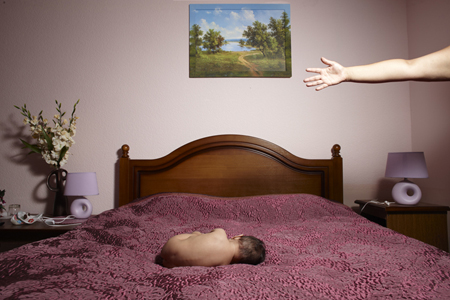
© Richard Ansett 2011/IZOLYATSIA Foundation for Cultural Initiatives
- There is a very subtle line between between documentation and creating a new mythology in your works. How do you situate them between these categories?
- Although we are more used the idea that photography is not a truthful representation of reality, there is a part of us that is always seduced. My practice is fully engaged with creating works from reality that cannot be entirely trusted; the overt lighting and deliberations that reveal the artist as present are also a kind of slight re-staging of life. This deliberate dislocation is the reason why my works seem neither fully fantasy or reality and often misunderstood. The message is simply that everything is not necessarily as it seems; life is more complex outside of the carefully constructed universes we have created around ourselves to rationalise the world. I walk a very narrow path between success and failure.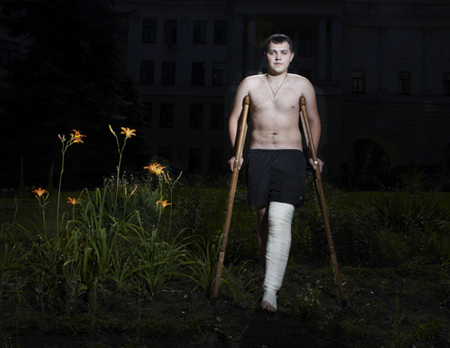
© Richard Ansett 2011/IZOLYATSIA Foundation for Cultural Initiatives
- I do really like the idea, that healing can only come from within - which is the hub idea of the Hospital Garden. Can you go deeper and tell us how is your personal experience connected to this idea and how it extrapolates to the local context of the city of Donetsk?
- I arrived in Donetsk fractured, unsure whether recovery was possible. The context for how i had defined my life for years had been removed plunging me into a crisis of identity beyond the parameters I had been exploring in previous works as an adopted person with no genetic or social antecedence. The project began as empathy with the patients damage but also the brutal historical legacy of Ukraine itself. In my research of Ukraine and Donetsk the importance of fertility of soil and mineral wealth offered some hope of where recovery would come (all the subjects in 'Hospital Gardens' and 'Autistic Boys in a City Park' are asked to stand in the earth). There is a sense that Ukraine seeks solutions outside of itself, either looking west to the idealised model of capitalism or a harping back to the imposed discipline from the east; the solution is in-fact under your feet. The fertility of Ukraine is a forgotten national metaphor. Emotional healing even with support, can only ultimately come from within. This is less of a judgement of Ukraine and the complexities of your politics but more an osmosis of my own existential process to rationalise my life through an empathy with the state of Ukraine and the people of Donetsk.
In my personal statement i discuss that emotions within us are manifest in momentary glimpses of the lives of others and can be an exploration of the limits of ourselves. Exploring the complex nature of our emotional world offers hope and empathy to others. We are mostly exposed to similar emotional experiences, it is how we deal with these emotions that define us as individuals. This is no less true in these works, there are no borders to this human experience.
- I was struck by the metaphors and archetypes which are present in the project. For example, the notion flower, the way you use human body etc. How do you define these narratives?
- I have touched on the idea of fertility in the previous answer and a further exploration of this is the flowers to accentuate the metaphor. I understood the importance of flowers in Ukraine culture and wanted to include flowers to identify with Ukraine more directly. Ultimately flowers have been an important part of the allegory and metaphor within art for centuries and those same meanings still resonate today. I have used flowers in work before and regardless of any of the extended metaphors, they personally refer directly to my sexuality which felt at odds with the clumsy and narrow concepts of male and female sexuality i was exposed to in Donetsk. Attitudes to sexuality can be a barometer of a society's progress towards personal freedom. The idea of society is intangible but prejudice towards one group or another oppresses the whole.
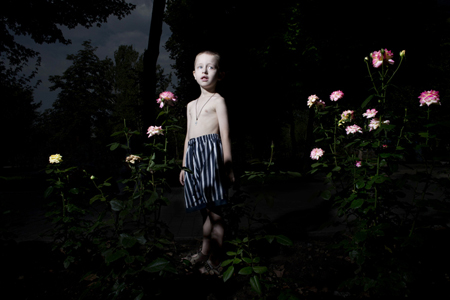
© Richard Ansett 2011/IZOLYATSIA Foundation for Cultural Initiatives
The Socialist realism movement has always been an interest and i use elements of this in composition to convey the sense of propaganda. Specifically in Ukraine this was something that i felt i could refer to more directly and I played more overtly with these concepts; the man with the strong body standing with crutches looks East, the boy with the head injury lies alone on the ground like a wounded Russian soldier and the title image for the show of the hand like an enormous sculpture of the worker against a dramatic sky (i used one of the IZOLYATSIA factory workers for this image).
- How would you define the place and the role of photography in contemporary art system?
Photography's power and disability as art is that it is the visual medium of the age. As a fine art practice it competes with a bombardment of conventional narration in media. The access to the technology to create images has never been so great or popular but this democratisation is irrelevant to photography's place in art. The simplicity of the physical act of photography masks the complexity in creating works of any value to others. A child can take a photograph as easily as they can daub some paint on a piece of paper but it may not be of interest to a wider audience. In terms of art history, photography had only just started to be considered as having an important role before it was declared dead. This is an argument from those under pressure to feed the continual stream to fill the blogs and magazines. Works of value are being eaten up in this greedy scramble, celebrated for a moment and then discarded with a click. We must create more space and time to consider the greatness of works.



